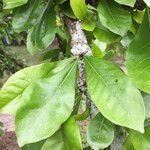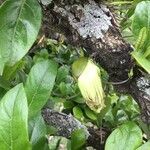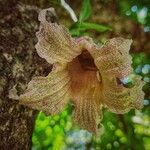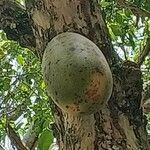Tree to 10 m tall and 30 cm d.b.h., the branches usually crooked, the crown open; branchlets mostly lacking, smaller branches thick, subterete, with alter-nate short-shoot projections each bearing a fascicle of leaves from its center. Leaves of various sizes within each fascicle, simple, obovate, the tip obtuse to acute, the base attenuate, petiole lacking, 3.4-26 cm long and 1.0-7.6 cm wide, chartaceous to rigid-chartaceous, secondary veins 5-14 on a side, the midvein raised above; lepidote above and beneath, otherwise glabrous above, beneath pubescent along midvein with simple and forked trichomes, plate-shaped glands at base of blade beneath, drying grayish-olive. Inflorescence one or 2 cauliflorous flowers borne on larger branches or trunk, the pedicels lepidote, 1.5 cm long. Flowers with a musty odor, calyx bilabiately split to the base, each lobe 1.8-2.6 cm long and 1.3-2.4 cm wide, mostly glabrous with plate-shaped glands on the upper half of lobes, slightly lepidote at the base; corolla off-white to yellowish-white with purplish venation on the lobes and purplish lines on the tube out-side, tubular with a transverse fold midway across the lower side of the throat, fleshy, 4.1-7.4 cm long and 3.1-4.5 cm wide at the mouth of the tube, the tube 2.8-4.5 cm long, the lobes triangular with the apex extended as a narrow point, 2.5-3.1 cm long, sparsely lepidote or stalked-lepidote on the tube outside and near the mouth of tube inside, more densely so at the level of stamen insertion, papillate-glandular on the lobes outside and sparsely so inside; stamens sub-exserted, the anther thecae thick, partially divergent, 5-8 mm long and 2.5-3.5 mm wide, the anterior filaments 2.8-3.2 cm long and inserted 6-11 mm from the base of the tube, the posterior filaments 2.8&-3.3 cm long, inserted 7-15 mm from the base of the tube, the staminode 1-3 mm long, inserted 5-11 mm from the base of the tube; pistil 4.0-4.9 cm long, the ovary rounded conical, 5-7 mm long and 4-7 mm wide, 3-6 mm thick, lepidote, the ovules multi-seriate on 4 placentae; disc annular-pulvinate, 3-4 mm long and 8-11 mm wide. Fruit a pepo or calabash, spherical to ovoid-elliptic, 13-20 cm in diameter to 30 cm long, the thin hard shell smooth, lepidote-punctate; seeds small, thin, wingless, 7-8 mm long and 4-6 mm wide, scattered through the pulp of the fruit.
More
Crooked tree to 10 m, 30 cm Ø. Leaves in scattered bundles on the rough twigs, obspathulate, sometimes short-acuminate, without petiole, up to 26 by 7½ cm. Flowers solitary or in pairs on the twigs, of a musty odor; calyx 2-lobed to the base; corolla 4-7 cm, dirty white or pale greenish, purplish veined, finally turning dull purplish, the wide tube with a transversal fold. Fruit broad-ellipsoid to globular, 13-20 by up to 30 cm, indehiscent, with a hard shell.
A shrub or tree. It grows to 10 m tall. It is evergreen. The leaves are arranged in spirals and are long and narrow. They are simple and dark green. They are 27 cm long. The bark is deeply cracked and corky. The flowers are round and bell shaped. They grow in long drooping heads. The fruit hangs like balls on long stalks. The fruit are 30 cm long by 18 cm wide. They are green. They have a hard outer rind and white pulp containing seeds.










